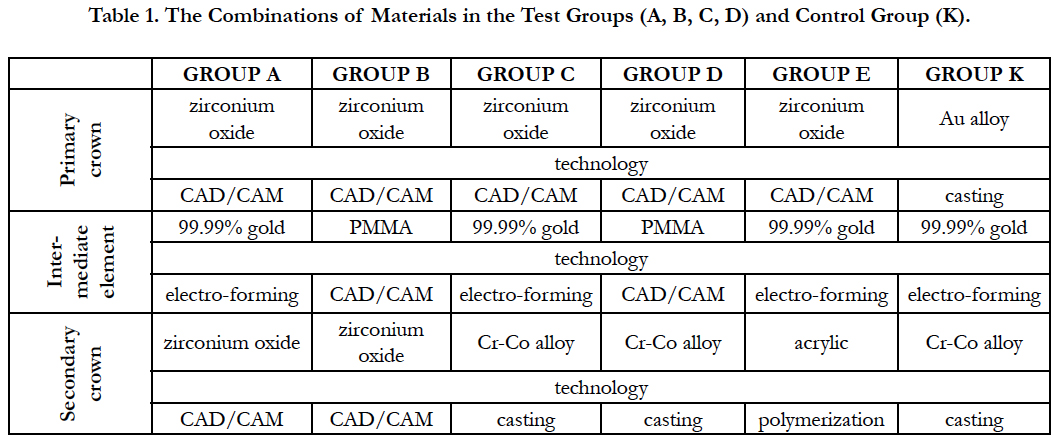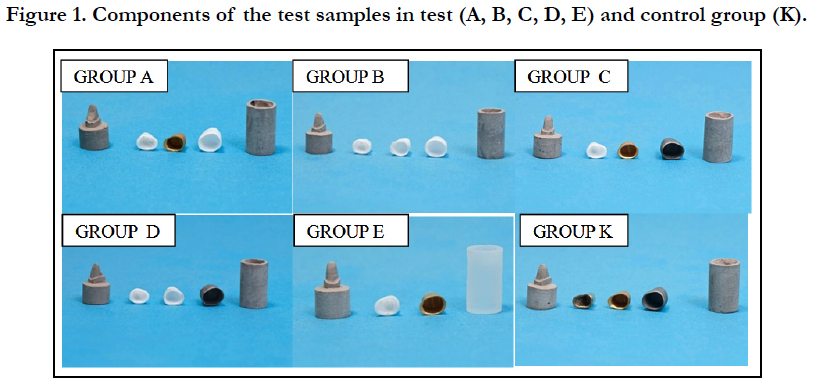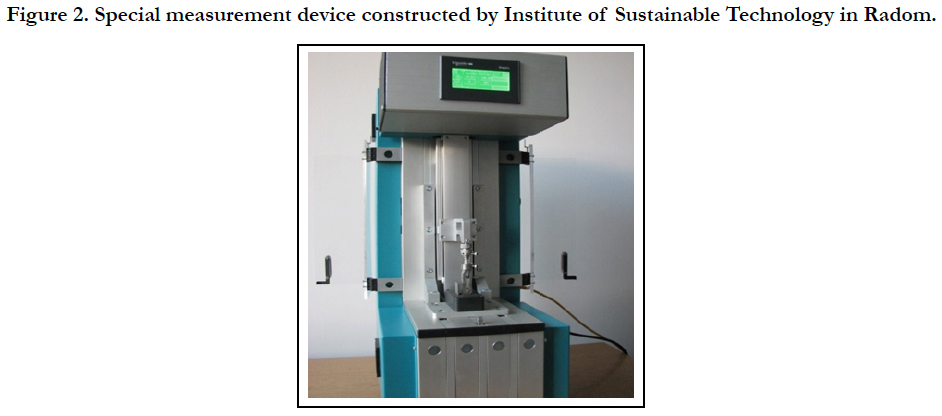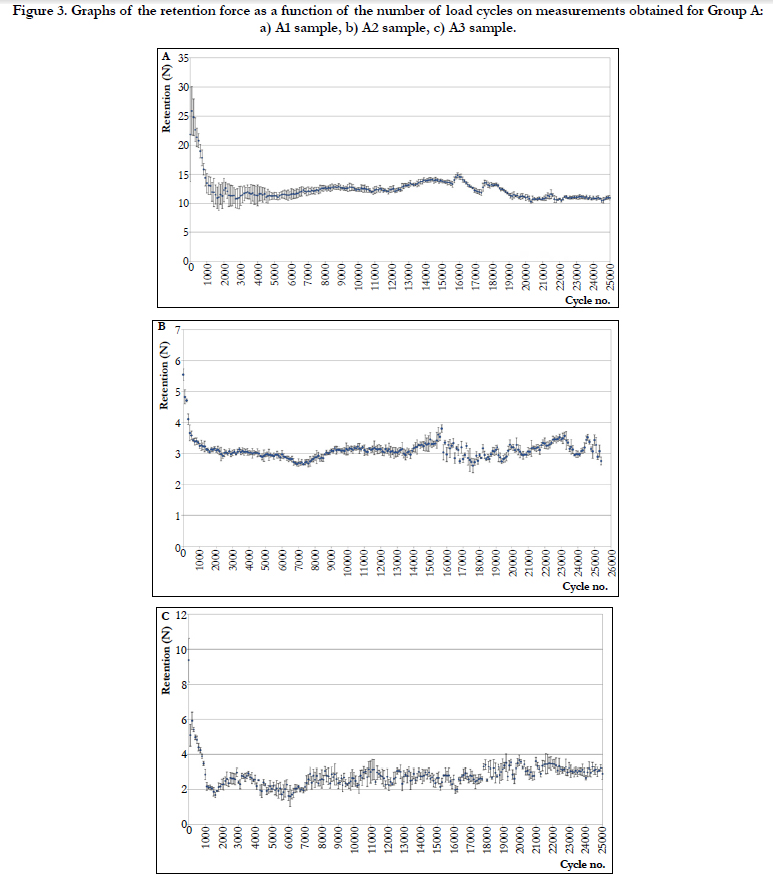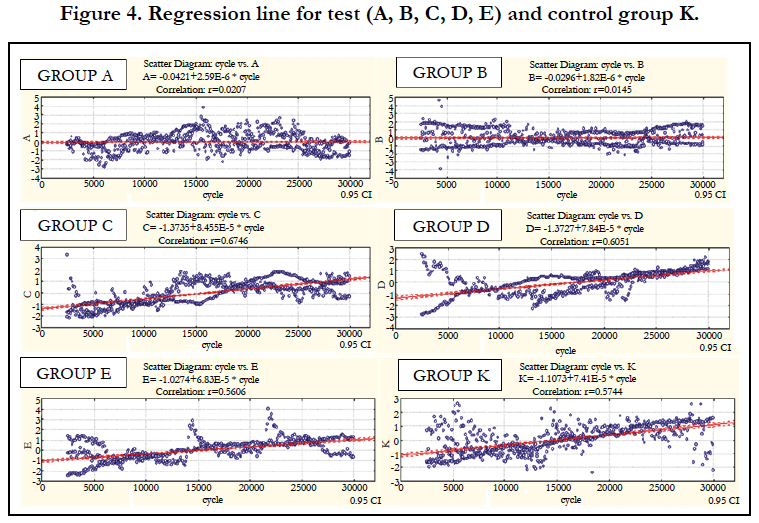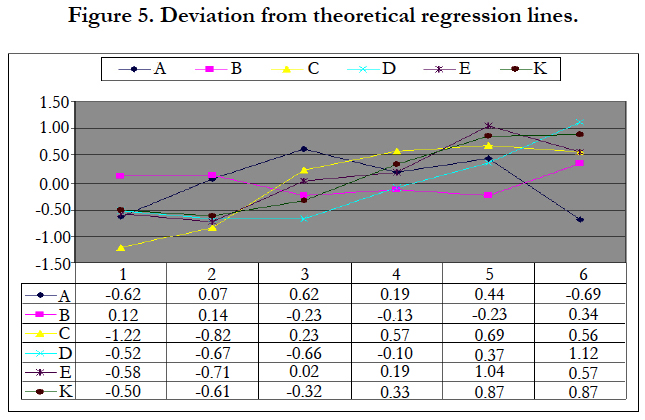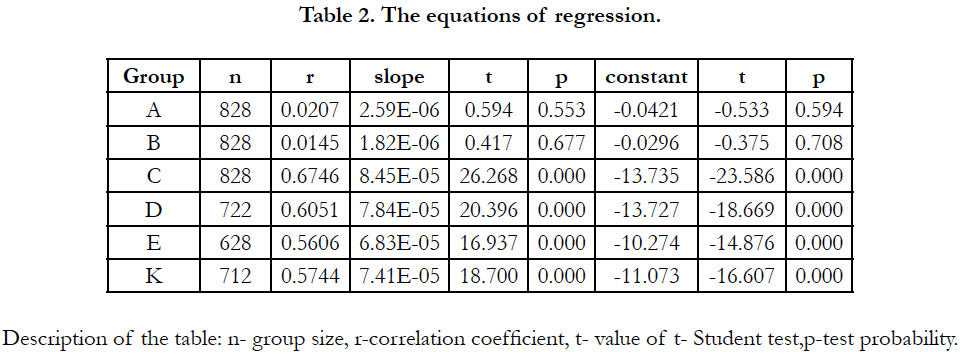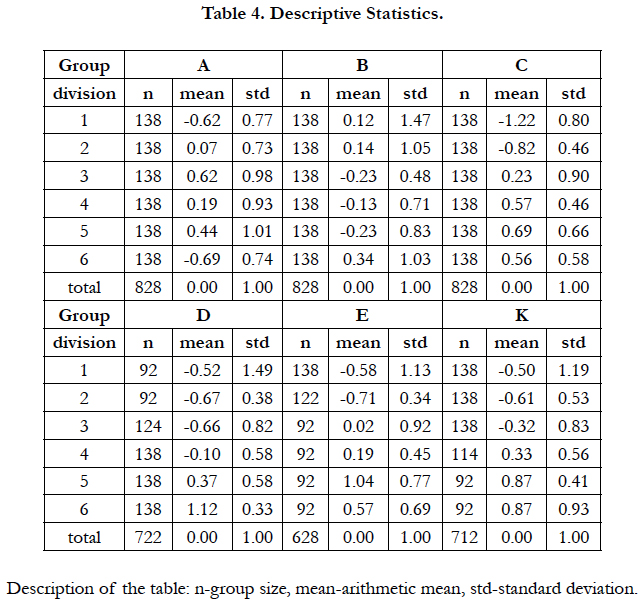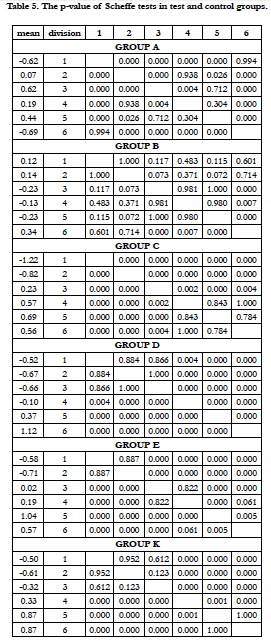The Evaluation of Changes in Retention Force Values in Three-Element Telescopic Crown Systems using Simulated Load Cycles
Kochanek-Leśniewska A1*, Majcher A2, Mierzwińska-Nastalska E1
1 Department of Prosthodontics, Medical University of Warsaw, Ul, Nowogrodzka, Warszawa, Poland.
2 Institute for Sustainable Technologies, National Research Institute in Radom, Ul. K. Pułaskiego, Radom, Poland.
*Corresponding Author
Anna Kochanek-Leśniewska, Ph.D,
Department of Prosthodontics, Medical University of Warsaw.,
Ul. Nowogrodzka 59, 02-006 Warszawa, Poland.
Tel: +48 22 502 18 86
Fax: +48 22 502 21 45
E-mail: a.kochanek-lesniewska@wp.pl
Received: November 20, 2017; Accepted: December 27, 2017; Published: December 29, 2017
Citation:Kochanek-Leśniewska A, Majcher A, Mierzwińska-Nastalska E. The Evaluation of Changes in Retention Force Values in Three-Element Telescopic Crown Systems using Simulated Load Cycles. Int J Dentistry Oral Sci. 2017;4(12):565-574. doi: dx.doi.org/10.19070/2377-8075-17000111
Copyright: Kochanek-Leśniewska A©2017. This is an open-access article distributed under the terms of the Creative Commons Attribution License, which permits unrestricted use, distribution and reproduction in any medium, provided the original author and source are credited.
Abstract
The development of CAD/CAM technology created the possibility of using three-element telescopic crowns systems in various material combinations. Methods of verification of new solutions are necessary before their clinical use.
The aim of the study was to develop a method of assessing the stability of the force retention in three-element telescopic crown systems in selected combinations of materials.
Material and Methods: Material consisted of the three-element telescopic crown systems, collected in five groups: A (ZrOAuGalv-ZrO), B (ZrO-PMMA-ZrO), C (ZrO-AuGalv-CrCo), D (ZrO-PMMA-CrCo), E (ZrO-AuGalv-acrylic) and a control group (K: Au-AuGalv-CrCo). A fundamental part of the method was the special measuring device with software. The retention force was examined in the range of 0-30 000 cycles of engagement and disengagement of crowns.
Results: There was no statistical significant differences between the changes of the retention force in groups A vs B and C vs D. The regression analysis showed that groups A and B are groups with the greatest stability.
Conclusions: The telescopic crowns made from zirconia in CAD/CAM technology ensures the most stable retention force irrespective of the type of intermediate element. The special attention should be paid to the type of material from which the external crown will be made.
2.Introduction
3.Aim of the Study
4.Material and Methods
5.Results
6.Discussion
7.Conclusion
8.Acknowledgement & Declarations
9.References
Keywords
Retention Force; Telescopic Crown; CAD/CAM.
Introduction
Telescopic crowns can be a beneficial solution in the planning procedure and medical rehabilitation for patients with residual dentition as well as during the reconstruction of the partial edentulous, where it is possible to perform intraosseous implants. Additionally, telescopic crowns can be used under clinically difficult conditions: patients with extensive missing teeth, after craniofacial surgery following cancer, patients who are affected by periodontal disease, cleft palate with varying degrees of intensity and during the reconstruction of the dental arches with a reduced vertical dimension caused by pathological tooth wear [1-12]. Most of these types of diseases are widespread in our civilization. There are different divisions of telescopic crowns related to their geometry, the method of the preparation of teeth, construction and materials as well as technologies that can be used to make them. Traditionally telescopic crowns constitute a two piece system, in which the primary crown is permanently cemented onto the tooth and the secondary crown is a part of removable denture or removable bridge [1, 2, 13-21]. The development of CAD/CAM technology and its application in dental prosthetics created the possibility of new solutions in the design of dental restorations, as compared to, e.g., those made of a three-element telescopic crown system. This system consists of a primary crown and secondary crown and an intermediate element mounted between them. The individual components of these systems can be made using CAD/CAM technology. One of the materials used for this type of crowns including both primary and secondary crowns is zirconium oxide [3, 22-27]. The intermediate elements, also called intermediate crowns may be performed in CAD/CAM with the use of different materials or the method of electroforming with the use of 99.99% gold.
In this study, the three-element crown systems included the systems with the intermediate element made in the electroforming technology. This element cannot function as part of an independent element and require incorporation into the third structure, becoming a part of multi-layer construction.
Retention telescopic crowns are associated with the contact surface of the crown in the system and it depends on many factors, mainly the geometry of the crown and the type of material used to make the crowns [28-38]. The developments of materials and new technologies that can be used in dental prosthetics create the prospects of the appearance of new design concepts and materials in the near future. Therefore, it is important to create and develop new methods necessary for the rapid and simple preliminary evaluation of new solutions before their clinical use. The article presents the results of the assessment of the stability of retention by using simulated cyclic loading, with a significantly increased number of cycles. The presented method can be an important instrument for the rapid evaluation of new types of design and material combination systems of telescopic crowns.
Aim of the Study
The aim of this study was to analyse changes in the retention force in three-element telescopic crowns systems provided with an intermediate element in selected combinations of materials. Moreover, the study focused on the stability of the retention force in different study groups while using a method of evaluation especially designed for this purpose.
Material and Methods
Material for the study consisted of 18 three-element telescopic crown systems, collected in five test groups (A, B, C, D, E) and one control group (K) representing a specific combination of materials. The test and control groups are shown in Table 1 and Figure 1-2.
All tested groups (A, B, C, D, E) had internal crowns, which were made of zirconia in CAD/CAM technology. The external crowns in Groups A and B were made of zirconium oxide, milled and sintered in CAD/CAM, but in Group C and D they were made of Cr-Co alloy by a casting technique, whereas, in Group E, external crowns are made of acrylic material by pressure polymerization. The indirect crowns (intermediate elements) in Groups A, C and E were made of 99.99% gold by a electroforming technique, and in Groups B and D of PMMA (polymethyl methacrylate) milled in the CAD/CAM technology. In order to visualize the type of material combination, it was decided to describe them as follows: Group A (ZrO2-AuGalv- ZrO2), Group B (ZrO2-PMMA-ZrO2), Group C (ZrO2-AuGalv-CrCo), Group D (ZrO2-PMMA-CrCo), Group E (ZrO2-AuGalv-Acrylic), and Group K (Au-AuGalv- CrCo).
Telescopic crowns used in research were made as a crown with a 1º taper. To complete the primary crowns, a 6 mm height pillar of the lower canine with chamfer according to the rule established for telescopic crowns preparation was prepared.
The pillar was repeatedly reproduced using silicon impression material (Finosil, FINO GmbH, German). Based on silicone forms, gypsum pillars were made to scan in order to perform the primary crowns in the CAD/CAM (T-CAM gypsum, Poland). Moreover, the gypsum Stodent IV (Zhermack, Italy) was used while duplicating pillars for use in the implementation of the internal crowns casting technique. Primary crowns were made of zirconium oxide (DD BIO ZW, Dental Direct, Germany) in CAD/CAM technology (milling machine I MES, Germany), which was based on the scanning pillar (3 SHAPE scanner, Denmark). The casted primary crowns were made of gold alloy according to the rule established for the casting method. The crowns were modelled from wax (Koronenwacks oraz Cervicalwacks, Bego, Germany) and cast from gold alloy (AUROLLOYD, Bego, Germany).The intermediate crowns were made from PMMA (PMMA, T-CAM, Poland) in CAD/CAM technology and electroformed gold (AGC MICRO, Wieland, Germany). The secondary crowns were made of Cr-Co alloy (WIRON 88, Bego, Germany), acrylic (Vertex, Vertex- Dental B.V, Netherlands) and zirconium oxide (DD BIOZW, Dental Direkt, Germany), respectively, by means of a technique appropriate for each of those materials.
Additionally, the Diemet- E resin (Diemet-E, Erkodent, Germany) cylindrically shaped bases with a diameter of 10 mm were designed. These bases served as an element facilitating the positioning of the tested system in the grip of the measuring device.
The bottom base contained a replica of a pillar, which was used to build the primary crown, and it was an element on which the primary crowns were cemented on using RelyX U200 material (Rely X U200, 3M ESPE, USA). This material is a double cured, selfadhesive cement containing resins. The upper base was a hollow cylinder of the external crown, which was fixed to it. In systems where the secondary crown was an acrylic element, the whole base was made of an acrylic fast-polymerizable material (Vertex, Vertex- Dental B.V, Netherlands) to facilitate the process.
The measurements were performed in five study groups and one control group. The study included 18 samples in total. Each study group and the control group were represented by 3 samples. These samples were designated as A1, A2, A3 (Group A), B1, B2, B3 (Group B); C1, C2, C3 (Group C); D1, D2, D3 (Group D); E1, E2, E3 (Group E) and in the control Groups K1, K2, K3.
In order to assess the changes in the retention force, a method was developed that allows the execution of appropriate measurements and obtaining the necessary data for further analysis. For the main purposes of the planned research, as part of the assessment methods of the analysis of the changes in the force retention, a special research arrangement to evaluate the retention telescopic crowns was made for the project and constructed in cooperation with the Institute for Sustainable Technologies in Radom [39]. The measurement device allowed the following: determining the force needed to connect and disconnect crowns, making measurements of the force, and recording and analysing the measured values (Figure 3). The force generation system was built using a screw linear drive with a stepper motor. The maximum frequency of the load cycles depended on the distance engagement and disengagement of the crown. The force measurement was performed using a gauge force sensor for tensile and pressure forces (type CL 17pm, Zepwn) and the relative incertitude limits of not more than 0.13% (Class 0.2 - calibration certificate LWS/026/2013). The lower base of the tested system was placed in the handle that was fixed to the force sensor bar. The base of the upper system provides the concentricity of the two parts. The control system test was realized using a PLC controller (type TM258, Schneider Electric- SE). It served as the power unit with the stepper motor (BR536W131, SE) and the engine controller (SD328AU2552, SE), while communicating with the CAN open trial. Performed tests were based on cycles connecting and disconnecting crowns in the studied systems and following the measurement of retention.
Figure 3. Graphs of the retention force as a function of the number of load cycles on measurements obtained for Group A: a) A1 sample, b) A2 sample, c) A3 sample.
After a series of tests, it was decided to test the following parameters using a specified sequence of measuring test. The tests are described by the sequence:
[P(lr, vz, npp)]0,
[M(Fz, vr, ncp)]1, [P(lr, vz, npp)]1,
[M(Fz, vr, ncp)]2, [P(lr, vz, npp)]2,
…
[M(Fz, vr, ncp)]N, [P(lr, vz, npp)]N,
where, P- is a function of measurement, M - function perform cyclic loading (connecting and disconnecting crowns) [39].
In the M-function of the performed load, crowns were engaged at velocity vr until obtaining a value of the force Fz (100 N) and, at the same velocity, the crowns were separated. After 100 repetitions of the cycle load, the measurement of retention force was performed five times. The tests were carried out in the range of 0 to 30 000 load cycles of joining and separating of telescopic crowns. The function of measurement (P) was carried out in such a way that the telescopic crowns were engaged with the velocity vz (velocity many times lower than the vr) until the force Fz (100 N). Then, with a fixed step as a multiple of the basic step k of at least 0.01 mm, the crowns were disconnected at the same velocity.
In the course of the movement, the force was measured with a frequency of 20 Hz. After each step, the maximum value of the measured force was recorded.
Programming parameters of the tests were carried out through the operator’s panel connected to PLC interface with Modbus RTU protocol. The measurement results were transferred automatically to the PC through the Ethernet connection.
The axial mounting of crowns was the initial point for carrying out repeated, multiple cycles of connecting and disconnecting crowns. In the tests, the primary crowns were cemented on the lower bases using dual cement RelyX U200 (3M ESPE, USA). After binding the material, excess cement was removed, and the sample was analysed. The lower base was placed in the holder of the measuring apparatus, and the procedure for mounting the external crown in the upper base was initiated and the intermediate element was mounted within the interior of the secondary crown. The secondary crowns were precisely positioned relative to the primary crown using the function-testing device. A dual composite cement RelyX U200 (3M ESPE, USA) was used to mount secondary crowns and intermediate elements. Only in the case of the test Group E, where the secondary crown consisted of acrylic, was the intermediate element connected to the upper base with the use of resin Pattern Resin (GC, Japan).
The computer (PC) connected to a device was used to collect and automatically save measurement data. Additionally, the package LabView software allowed the following:
- graphically displaying the run forces measured during the crown testing with a set number of trials and scaling,
- choosing the retention force detection methods as the maximum value of the force run graph or a local maximum, determined by finding the first and second derivatives, or finding the maximum value in a defined range,
- displaying the designated retention.
The changes in forces were recorded in the test data files. Then the force graphs in relation to time were made as a function of the distance of the disconnection of crowns. The retention was designated by the maximum value force that occurred during the disengagement of crowns. In the case of crowns where the force did not have global maximum, the local maximum was determined by the method of calculating the second derivative force or by finding the maximum value in a specified range. The next step in the processing of measurement data was calculating the average value of the retention force and the standard deviation of force values for repeated runs. The results of measurements were saved in spreadsheets enabling them to be further analysed.
The statistical analysis was performed using STATISTICA 8.0. In the statistical analysis designed as an integral part of the method, a data analysis algorithm was used. This algorithm was based on regression analysis and correlations in order to generate a ranking of the groups from the most to the least stable alinement. Moreover, it complemented the data obtained by the analysis of the deviations from the straight theoretical model using one-way variance analysis and the Scheffe test.
Results
In this study, the full range of testing was completed on 16 samples. Two out of 18 tested samples did not reach the full range of testing: the sample marked as E1 (Group E) and the sample K2 (control Group). Sample E1 failed at the level of 10000 cycles, which led to fracture of the post in the lower base retaining the sample in the holder of the measuring device. Sample K2 failed at 16800 cycles where there was a total loss of retention in this system of telescopic crowns. The results of the measurements were shown in the form of the dependence of the retention force as a function of the number of cycles performed for the individual samples of the test Groups A, B, C, D, E and the control Group K. The data obtained have been plotted on graphs (Figure 4 shows the results of Group A). The graphs, due to the limitation of scaling, show the results to the range of 25 000 cycles. Analysis was performed for the full range of a study involving 30000 cycles.
Each sample obtained 1505 individual measurements of the retention force, which was placed in the 301 series of data, where each series was the average of five times the measurement of the retention force with the standard deviation made after every 100 subsequent loading cycles. The main purpose of this method was to evaluate changes in the retention force, to specify the period of its stability as a function of the number of cycles of engagement and disengagement of crowns.
The graphic analysis of the scattering in the plots of the retention force as a function of number of cycles for each sample indicated that the range 0 - 2400 cycles of the joining and separation of a crown is an area with the greatest changes in the value of the retention force, which is highly volatile in this range of tests. For this reason, it was decided to standardize testing and to search for periods of stability in the range of 2500-30000 load cycles. Therefore, the range from 0 to 2400 cycles was omitted, recognizing that part as the "initial phase of measurements".
The measurement data was standardized in the range of 2500 - 30000 cycles of engagement and separation of crowns. All samples in each group were calculated using a regression equation (Figure 5). The estimation results and the tests results are shown in Table 2. Regression analysis showed that, in terms of the stability of the retention force, the results of the study groups of subjects can be ranked as follows: B, A, E, K, D, and C. The criterion for the ranking was the accepted values of the slopes of regression lines. Table 3 shows the values of t-statistics test of parallelism, and corresponding p-values. Tests of parallelism regression for Group A and Group B showed no statistically significant differences: A123 vs B123 p = 0.4133. Slopes of the regression lines for Groups A and B are near 0, whereby regression lines were substantially parallel to the axis and did not differ statistically from each other (A = B).
The slopes of the Groups A and B do not differ from one another, but they are statistically significantly different from all other groups, including the control group (A vs C and A vs D, A vs E, B vs C, B vs D, B vs E, E vs C). In addition, the slope of the regression line for Group C differs significantly from all the slopes except for the slope of Group D (C = D). Additionally, the slopes of the two groups achieve the highest value.
The results of the regression analysis were supplemented by the analysis of deviations from the theoretical line. Model ANOVA was used. As multiple tests, Scheffe tests were used. Ranking from 2500 - 30000 cycles of engagement and separation of crowns were divided into six equal following divisions of load cycles: Division 1: 2500-7000, Division 2: 7100-11600, Division 3: 11700- 16200, Division 4: 16300 -20800, Division 5: 20900-25400, and Division 6: 25500-30000. The dependent variable was the force of retention in each group, and the grouping variable was the division. The descriptive statistics are included in Table 4. For all models of variance analysis p values were less than 0.001; therefore, Scheffe tests were calculated for all analyses. The results are included in Table 5.
On the basis of the results and statistical analysis in the range of 0 to 30000 cycles of connection and disconnection of three-element telescoping crowns, Group A and Group B can be defined as the groups of stable retention levels, regardless of the increasing number of load cycles. There is no statistically significant difference between these groups, which indicates that the systems of telescopic crowns in which the inner and outer crowns are made of zirconia in the CAD/CAM technology, independent of the type of the intermediate element, can be expected to have a stable value of the retention force regardless of an increasing number of load cycles.
In the group ranking and the lack of significant differences between the Groups A vs B vs C and D indicate that the type of material from which the secondary crown is made affects the value of the retention force with increasing number of load cycles. Group B is a group of the most stable retention levels in the test in the range 0-30000 load cycles. Group C is a group with the largest change of the retention force as a function of load cycles and with the greatest tendency to growth.
Discussion
The studies on the retention force of telescopic crowns show large changes in the observed values of measurements performed during tests. The biggest changes can be observed in the initial testing phase of crowns. This phenomenon explains the strain of the surface of the crown depends on the malleability of materials use. This phenomenon is characteristic especially for crowns made of gold alloys, where the observed initial decrease in the value of the retention force is momentarily stabilized until another decline in value and eventual complete loss of retention [1, 31, 32, 35, 36]. In this study the initial phase in all groups was in the range of 0-2500 cycles, followed by a period of relative stabilization of the value of the retention force in the range of 30000 cycles.
The changes in the retention force during the use of telescopic crowns are caused by tribological phenomena modifying the surface structure of the crowns. The most important factors include the tribochemical impact, abrasion, adhesion, and defects within the surface. These factors can occur separately or overlap, which can be related to the state of material and construction of the retention element [34-36].
In publications, it is stated that a range of 10 thousand cycles of load corresponds to 10 years of using the prosthesis in clinical conditions, provided that the prosthesis fitted and removed three times a day [40-42]. When fitted and remove twice a day, it corresponds to 13-14 years [43]. The pro-health education for patients promotes healthy eating habits and a diet based on five small meals a day. This means that, in accordance with the recommendations of hygiene for dentures, the prosthesis is removed at least six times a day, taking into account that the prosthesis should be removed after each meal and at night and washed. Therefore, it seems reasonable to extend the test cycle.
The study selected the canine as a pillar model because their anatomical structure makes canines the most common residual teeth and often the only pillars used in the planning procedure and prosthetic rehabilitation [1]. Beuer et al., [33], Engels et al., [43] and Güngör et al., [19] decided to choose, for this purpose, the first premolar in the mandible in their presented study. In the study of the 14-points of zirconium oxide supported on six telescopic crowns of the zirconia double crown system Groesser et al., [44] presented the lowest value of the retention force for canines, which is higher for premolars and the highest for the molars.
The authors explained this phenomenon by the extent of the surface and the geometry.
Premolars and molars are the teeth with homogeneous geometry, while the surface of a canine is difficult to adapt with a short palatal part and adequately long buccal part subject to friction. The retention value obtained in the study of a single support tooth cannot refer to the final retention of the prosthesis based on it, especially if there are other support teeth provided with telescopic crowns. Retention of the prosthesis based on more than one telescopic crown is not a simple sum of the individual pillars and the retention does not correlate with their number [35].
The retention experiments were performed in experimental conditions that do not exactly correspond to the situation that can occur in the mouth of the patient. They are simplified models that are designed to help to broaden the knowledge of the tribology of the combinations of materials.
In the assessment of the test results the basis was the standardization of the measurement data, because the method of evaluation does not refer to the absolute value of the retention force. It shows changes during the following load cycles. Based on the results, it can be concluded that the groups in which the elements are made using CAD/CAM show a high stability of the retention force, which indicates that they are a preferred solution for clinical use, which is also an important alternative to the traditional combinations of materials. This is confirmed by Beuer et al., research, assessing the impact of the pillar height, the type of material of the internal crown as well as the taper on the force retention. In their study the authors used systems of telescopic crowns where the internal crown was made of gold alloy in the first group and zirconium oxide in the second group. The external crowns in both groups were made of electroformed gold. This study demonstrates that all of these factors have an influence on the retention force. The authors indicate that, in a situation with a 2° taper and long supporting teeth, zirconia primary crowns are an alternative to primary gold alloy crowns. The authors present a general conclusion from this research, which indicates that the internal crowns made of zirconium oxide show a higher retentive force than crowns made from gold alloys [33]. In addition, clinical observations made by Zafiropulos et al., show that modern material solutions might be preferred solutions in clinical use [26].
Studies were carried out in the project phase without the use of lubricant, but the construction of the measuring device allows its dosage. In the literature, such studies can often be found using artificial salivaas a lubricant, and solutions are prepared in various proportions with physiological salt solution or distilled water [31, 33-35, 40]. The presence of the lubricant may have an effect on the measured value of the retention force and the selection of materials [33]. The study of Bayer et al. did not show a significant impact of the presence of lubricant on the obtained values of retention force but the tendency did occur [35]. The use of a lubricant during the research makes test conditions closer to those existing in the oral cavity and allows the removal of optionally formed surface degradation products. Further research is planned on the issue, where it is assumed that tests will be performed in the presence of the artificial saliva between the two elements in order to assess the impact of this factor on the value and characteristics of the obtained measurements.
This research is a pilot study of designed studies with retention systems of telescopic crowns in different combinations of materials.
Conclusion
1. The CAD/CAM technology that allows one to make primary and secondary zirconia crowns in three element telescopic crown systems ensures the most stable retention force irrespective of the type of intermediate element mounted between them.
2. When planning telescopic crowns systems, special attention should be paid to the type of material from which the external crown will be made. This element has the greatest influence on the changes in the retention force in the range of observations that match clinical use.
3. When using telescopic crowns systems made of the traditional combinations of materials (Au-AuGalv-CrCo) the increasing retention force as a function of the number of load cycles may be accompanied by the risk of mechanical damage to the systems.
4. Because of the positive character of changes in the retention force observed for the material combination (ZrO2-AuGalv- CrCo), which is a combination of elements that are made using both modern technology and traditional methods of casting, the system can be considered in clinical practise.
In conclusion it should be noted that the current method of assessing changes in the retention force allows for the analysis of the telescopic crown systems that are based on currently used materials and modern technologies in a variety of combinations. It can be an instrument of rapid, initial verification of the new combinations of materials before the clinical research. The development of such methods seems to be particularly useful in the world of rapid progress in the fields of information technology and materials engineering.
The availability of new technologies and the possibility to apply the appropriate combinations of materials can significantly affect the achievement of successful rehabilitation of the masticatory system.
Acknowledgement & Declarations
The authors declare that they have no conflict of interest. This research did not receive any specific grant from funding agencies in the public, commercial, or not-for-profit sectors.
References
- L. Haupfauf. Dental Prosthetic. Partial dentures. Urban & Partner, Wrocław;1997.
- Dąbrowa T, Pławski A. Possibilities of Prosthodontic Treatment with Removable Partial Dentures and Telescopic Double Crowns System. Dent Med Probl. 48: 97-102.
- Koeck B, Wagner W. Implantologie, Urban & Fisher Münich; 2004.
- Ciechowicz B, Mierzwińska-Nastalska E, Wojda M, Kochanek-Leśniewska A, Michalik R. Zirconium oxide-based ceramic restorations made in the patient after pituitary gland tumour surgery: a case report. Protet Stomatol. 2011;1:43-50.
- Langer Y, Langer A. Tooth-supported telescopic prostheses in compromised dentitions: a clinical raport. J Prosthet Dent. 84(2):129-132.
- Pellecchia R, Kang K-H, Hirayama H. Fixed partial denture supported by all-ceramic copings: a clinical report. J Prosthet Dent. 2004 Sep;92(3):220-223.
- Sethuram A, Sahoo N, Sandhu H, Radhakrishnan K. Rehabilitation of a maxillectomy case with telescopic crowns: a case report. J Indian Prosthodont Soc. 2013 Sep;13(3): 236-239. PubMed Central PMCID: PMC3732727.
- Palmeiro MR, Piffer CS, Brunetto VM, Maccari PC, Shinkai RS. Maxillary rehabilitation using a removable partial denture with attachments in a cleft lip and palate patient: a clinical report. J prosthodont. 2015 Apr; 24(3) :250-253.
- Kranjcic J, Zabarovic D, Celebic A, Mehulick K, Komar D, Vojvodic D. Prosthetic modalities used to treat cleft palate patients in a university clinic: a 10-year review. Coll Antropol. 2013 June;37( 2):423-429. PubMed PMID: 23940984.
- Goswami R, Mahajan P, Siwach A, Gupta A. Telescopic overdenture: Perioprostho concern for advanced periodontitis. Contemp Clin Dent. 2013 Jun;4(3):402-405. PubMed PMID: 23940984.
- Ferrer JF, González AM, Galdón BO, Juanes KB, Iranzo FB, Tomás AC. Telescopic crowns in adult case with lip and palate cleft. Update on the etiology and managemen. Med Patol Oral Cir Bucal. 2006 Jul 1;11(4):358-362. PubMed PMID: 16816823.
- Güngör MA, Artunç C, Sonugelen M, Toparli M. The evaluation of the removal forces on the conus crowned telescopic prostheses with the finite element analysis (FEA). J Oral Rehabil. 2002 Nov; 29(11):1069-1075. PubMed PMID: 12453261.
- Wostmann B, Bankelhol M, Kothe, Ferger P. Dental impact on daily living of telescopic crown-retained partial dentures. Int J Prosthodont. 2008 Oct;21(5):419-421. PubMed PMID:18950064.
- Polansky R, Haas M, Lorenzoni M, Wimmer G, Pertl C. The effect of three different periodontal pre-treatment procedures on the success of telescopic removable partial dentures. J Oral Rehabil. 2003 Apr;30(4):353-363. PubMed PMID: 12631158.
- Kumar L, Sehgal K. Removable partial denture supported by implants with prefabricated telescopic abutments - a case report. J Clin Diagn Res. 2014 Jun;8(6):ZD04-06. PubMed Central PMCID: PMC4129252.
- Dąbrowa T, Panek H, Makacewicz S. Types of mechanisms supporting partial dentures using double crowns. Dent Med Probl. 2004;41( 3): 521-525.
- Wulfes H. Precision milling and partial denture constructions. Academia dental, International School Bego, Germany; 2004.
- Wirtz J, Hoffmann A. Galvanoprothetik-neue Wege zum biologischen Zahnersatz. Quintessenz, Berlin; 1999.
- Güngör MA, Artunç C, Sonugelen M. Parameters affecting retentive force of conus crowns. J Oral Rehabil. 2004 Mar;31(3):271-277. PubMed PMID: 15025661.
- Wenz HJ, Lehmann KM. A telescopic crown concept for the restoration of the partially edentulous arch: the Marburg double crown system. Int J Prosthodont. 1998 Dec;11(6): 541-550. PubMed PMID: 10023216.
- Wenz HJ, Hertrampf K, Lehmann KM. Clinical longevity of removable partial dentures retained by telescopic crowns: outcome of the double crown with clearance fit. Int J Prosthodont. 2001 Jun;14(3):207-213. PubMed PMID: 11484566.
- Rinke S, Buergers R, Ziebolz D, Roediger M. Clinical outcome of double crown-retained implant overdentures with zirconia primary crowns. J Adv Prosthodont. 7 (4): 329-37. PubMed Central PMCID: PMC4551790.
- Bergler M, Holst S, Blatz M, Eitner S, Wichmann M. CAD/CAM and telescopic technology: design options for implant-supported overdentures. Eur J Esthe Dent. 2008; 3(1):66-88. PubMed PMID: 19655559.
- Kurbad A, Ganz S, Kurbad S. CAD/CAM generated all-ceramic primary telescopic. Prostheses Int J of computerized dentistry. 2012;15(3):237-249.
- Kochanek-Leśniewska A, Ciechowicz B, Wojda M. Clinical and laboratory stages of manufacturing an overdenture supported on zirconium telescopic crowns. Protet Stomatol. 2012 Jun;3:190-196.
- Zafiropoulos GG, Rebbe J, Thielen U, Deli G, Beaumont Ch, Hoffmann O. Zirconia removable telescopic dentures retained on the teeth or implants for maxilla rehabilitation. Three-year observation of three cases. J Oral Implantol. 2010;36(6):455-465. PubMed PMID: PM20545536.
- Michalik R. Telescope crowns of the newera - part 1. CAD/CAM. 2014;3:6-9.
- Leśniewska-Kochanek A, Majcher A, Mierzwińska-Nastalska E. Analysis of change in the retention force value in the three-element system of telescopic crown made of zirconia. Protet Stomatol. 2014;6:384-498.
- Ohkawa S, Okane H, Nagasawa T, Tsuru H. Changes in retention of various telescope crown assemblies over long-term use. J Prosthet Dent. 1990 Aug;64(2):153-158. PubMed PMID: 2202814.
- Sakai Y, Takahashi H, Iwasaki N, Igarashi Y. Effects of surface roughness and tapered angle of cone crown telescopic system on retentive force. J Dent Mater. 2011;30(5):635-641. PubMed PMID: 21946483.
- Pietruski JK, Sajewicz E, Sudnik J, Pietruska MD. Retention force assessment in conical crowns in different material combinations. Acta Bioeng Biomech. 2013;15(1):35-42. PubMed PMID: 23957556.
- Stancić I, Jelenković A. Retention of telescopic denture in elderly patients with maximum partially edentulous arch. Gerodontology. 2008 Sep;25(3):162-167. PubMed PMID: 18194328.
- Beuer F, Edelhoff D, Gernet W, Naumann M. Parameters affecting retentive force of electroformed double-crown system. Clin Oral Invest. 2010 Apr;14(2):129-135. PubMed PMID: PM19343381.
- Bayer S, Zuziak W, Kraus D, Keilig L, Stark H, Enkling. Conical crowns with electroplated gold copings: retention force changes caused by wear and combined off-axial load. Clin Oral Impl Res. 2011 Mar;22(3):323-329. PubMed PMID: 20868454.
- Bayer S, Stark H, Mues S, Keilig L, Schrader A, Enkling N. Retention force measurement of telescopic crowns. Clin. Oral Invest. 2010 Oct;14(5):607- 611. PubMed PMID: 19609574.
- Bayer S, Kraus D, Keilig L, Gölz L, Stark H, Enkling N. Wear of double crown systems-electroplated vs. casted female part. J Appl Oral Sci. 2012 Jun;20(3):384-391. PubMed Central PMCID: PMC3881770.
- Eitner S, Schlegel A, Emeka N, Holst S, WillJ, Hamel J. Comparing bar and double- crown attachments in implant - retained prosthetic reconstruction: a follow- up investigation. Clin Oral Impl Res. 2008 May;19(5):530- 537. PubMed PMID: 18371100.
- Ciaputa T, Ciaputa A. Principles of performing prosthetic restorations. Elamed, Katowic; 2009.
- Majcher A, Leśniewska-Kochanek A, Mierzwińska-Nastalska E. A method and a device for evaluation of the retention of telescopic dental crowns. J Mech Behav Biomed Mater. 2017 May;69:362-367. PubMed PMID: 28161690.
- Bayer S, Keilig L, Kraus D, Grüner M, Stark H, Mues S, Enkling N. Influence of the lubricant and the alloy on the wear behavior of attachment. Gerodontology. 2011 Sep;28(3):221-226. PubMed PMID: 20545776.
- Wichmann MG, Kuntze W. Wear behavior of precision attachments. Int J Prosth odont. 1999 Oct;12(5):409-414. PubMed PMID: 10709521.
- Besimo CE, Guarneri A. In vitro retention force changes of prefabricated attachments for overdentures. J Oral Rehabil. 2003 Jul;30(7):671-678. Pub- Med PMID: 12791150.
- Engels J, Schubert O, Güth JH, Hoffmann M, Jauernig Ch, Erdelt K, et al. Wear behavior of different double- crown systems. Clin Oral Invest. 2013;17: 503-510. PubMed PMID: 22573245.
- Groesser J, Sachs C, HeiβP, Stadelmann M, Erdelt K, Beuer F. Retention forces of 14-unit zirconia telescopic prostheses with six double crowns made from zirconia - an in vitro study. Clin Oral Invest. 2014 May;18(4):1173-1179. PubMed PMID: 23963618.

